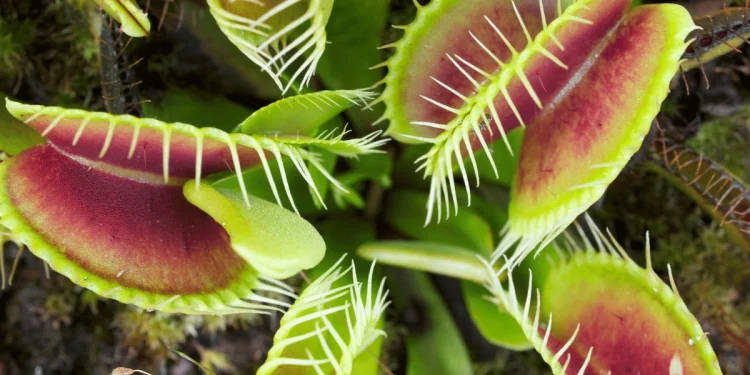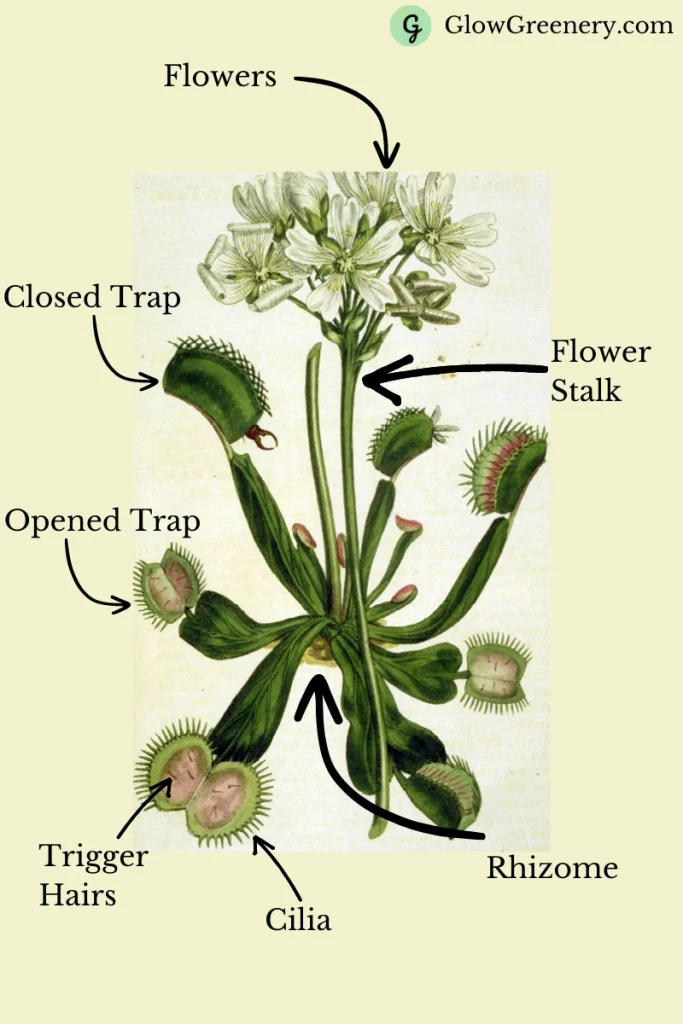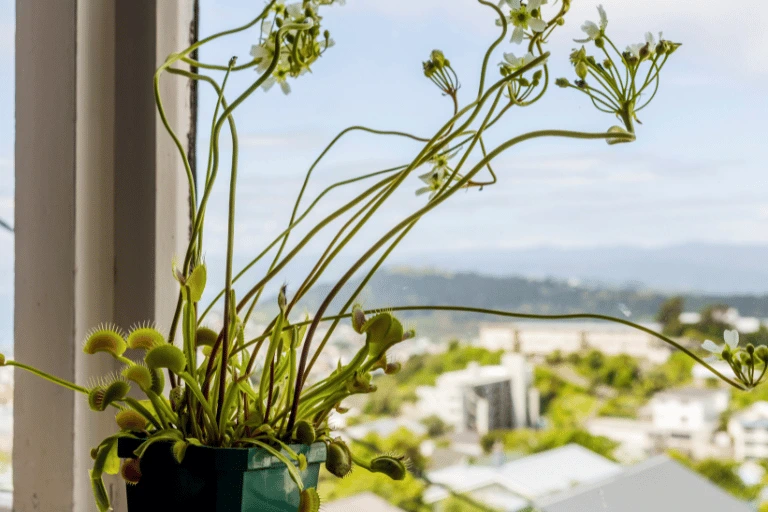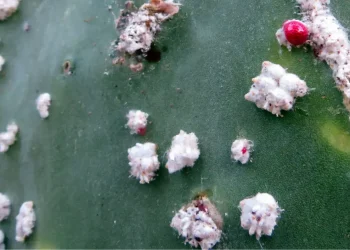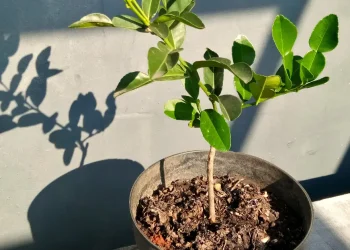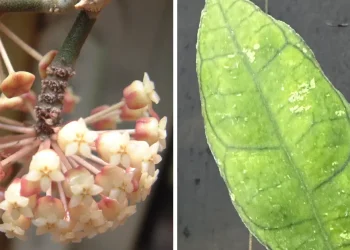Venus Flytraps, or, scientifically, Dionaea muscipula, is the most well-known carnivorous plant in the world. Over dozens of years, they evolved all their parts to thrive in the wet savannas of North and South Carolina in the United States.
The different parts each fulfill a crucial role in the plant’s life, either in terms of photosynthesis, reproduction, or nutrition. And yet, most people’s knowledge of this plant is shallow. But that’s gonna change today.
In this article, I will try to explain the function of each of the Venus Flytrap’s parts in simple terms so that even a beginning gardener can understand it. You will also see a diagram of the Venus Flytrap, so you can dive into the topic even more. Put on your thinking hat, and let’s get to work!
What are Different Venus Flytrap Parts (with Diagram)
Venus Flytrap is composed of a wide array of parts, each with its own unique role in the plant’s life.
If we start from the bottom, we have a root system and a leaf base, which acts as a sturdy foundation for the entire plant. Moving up, we can see the traps themselves. That are the star of the Venus Flytrap’s hunting game! Nestled within the traps, we can find the trigger hairs and a few other parts, which we’ll discuss all in just a moment.
And finally, the Venus Flytrap, despite its carnivorous nature, also has the ability to bloom. This happens annually during the spring season, typically between April and May. However, the blooming period is relatively short, usually lasting only for a few weeks.
You can see all the parts on the Venus Flytrap diagram below.
You can tap on the diagram to see it in full size. So the parts of a Venus Flytrap are:
- Roots and Rhizome
- Leaf Base and Stalk
- Traps
- Cilia
- Trigger Hairs
- Nectar secreting glands
- Flowers
Now, let’s put every one of these in focus.
Roots and Rhizome
Both roots and rhizome play vital roles in the plant’s nutrient supply.
The rhizome is a modified stem that grows partially beneath the surface. This thick, white, or pinkish bulb’s main purpose is to serve as a storage reservoir for nutrients. It also produces new shoots and roots, enabling the plant to propagate and expand its reach.
Meanwhile, the roots absorb nutrients and water from the surrounding soil and also help the plant stay steadily in place.
It’s pretty easy to tell these two parts apart. Check the image below.
If you take a look at your Venus Flytrap, the rhizome should be nearly all underground. Exposure to sunlight can damage it, and the rhizome can develop dark spots, which can be a sign of ongoing root rot.
It’s perfectly normal for a small portion of the rhizome to be visible above the soil. As the plant’s leaves offer some shade, it won’t cause many troubles. However, if a significant portion of the rhizome is exposed, you should repot your flytrap into a larger container to provide it ample space for proper growth.
Leaf Base and Stalk
Another crucial part of a Venus Flytrap is the leaf base and the stalk. The leaf base serves as the point of attachment between the leaf and the stem or branch.
It extends from the rhizome and forms the lower part of the leaf, which is connected to the traps.
It serves an important structural role, but also it’s crucial for photosynthesis. While the traps do also have some capacity for photosynthesis, the leaf base plays a more significant role.
When we talk about the stalk, we’re talking about a stem that will later flower, and it doesn’t grow traps.
What is really fascinating is the growth process of the Venus Flytrap. The plant will first grow the traps. These emerge just slightly above the ground, and even at this point, they are fully functional. And as the plant grows, the leaf base also grows, and the trap will slowly stand up.
Traps and all their Parts
Adult traps vary in size and typically range anywhere between 0.5 to 1.5 inches (1.3 to 3.8 centimeters) across the leaf. The current world champion has 2.4 inches (6.1 centimeters) across the leaf.
No matter the size, the trap always consists of two lobes. Right inside Venus Flytrap’s “mouth,” there are six sensitive hairs in total, three on each side. these hairs respond to the slightest touch. However, a single contact is not sufficient. The prey must touch at least two hairs within 30 seconds. If this happens, the trap will snap shut in as fast as 1/10 of a second.
Here’s a great instructional video from the National Institute for Basic Biology that shows the plant’s reaction.
As the trap snaps, an array of cilia comes into play. These tiny hair-like structures line the inner surface of the trap and play a crucial role in keeping the prey inside.
After the bug or animal is inevitably trapped, the plant secretes a cocktail of digestive enzymes into the closed leaves, which slowly break down the insect into simpler compounds that the plant can absorb. This happens through nectar-secreting glands that are also present on the inner side of the lobes.
Once the digestion is complete, the Venus flytrap reopens its leaves, and the leftover exoskeleton or other non-nutritive parts are discarded.
The trap is truly an interesting part of the plant. That’s why I also crafted an article focused mainly on that. Check out What’s on Venus Flytrap’s Diet and more about the eating mechanism, here.
Flowers
Venus Flytrap isn’t only a cruel creation of nature that eats others, it can also bloom. Venus Flytraps will usually bloom every year between April and May, but only for a few weeks at maximum. Flowers will emerge from the stalks, showcasing petals in various shades, often tinted with hues of white, pink, or green.
The flowers grow a lot higher than the traps. As a result, your 6-inch tall (15 centimeters) plant can reach even to 20 inches (50 centimeters) above the ground.
But the flowers are not there just to look good, they allow the plant to produce seeds and ensure its future generations.
When the Venus Flytrap blooms, it produces flowers that contain both male and female reproductive organs. The flowers attract pollinators, such as bees and other insects that transfer pollen between the two organs, facilitating fertilization.
Once the flower is pollinated, the plant develops seeds which are eventually dispersed, allowing for new Venus Flytrap plants to grow.
Venus Flytrap Dimensions
Venus Flytraps are relatively small, usually inhabiting only small spaces of about 1 to 2 square feet (0.09 to 0.18 square meters) in their native habitats. It is common to find multiple Venus Flytrap plants growing in close proximity to one another, each with its own root and rhizome structures.
Even though they are usually clustered in relatively small spaces, their roots usually expand a bit further, to about 2 to 6 inches (5 to 15 centimeters) from the plant, while reaching around 8 inches (20 centimeters) deep.
From the plant’s core, the leaf base and, eventually, traps expand. The traps begin to grow close to the ground. When the plant is fully grown, the individual traps are spaced at different heights, generally no higher than 8 inches (20 centimeters). And don’t worry, Venus Flytrap won’t eat you or your pet, as even the biggest trap ever recorded is only 2.4 inches (6.1 centimeters) across the leaf.
When Venus Flytrap blooms, it can reach even as high as 20 inches (50 centimeters) above the ground.
Bottom Line
The idea of being able to see a plant move and capture prey in real-time makes Venus Flytraps really fascinating. All this action is thanks to an array of specialized parts. As depicted in the Venus Flytrap diagram, these parts include the root and rhizome, leaf base and stalk, and the intricate traps with their trigger hairs, cilia, and nectar-secreting glands.
I hope you learned something new today. To continue learning about Venus Flytraps, you can check out my guide on Watering Venus Flytrap or an article about Venus Flytrap’s Diet.

